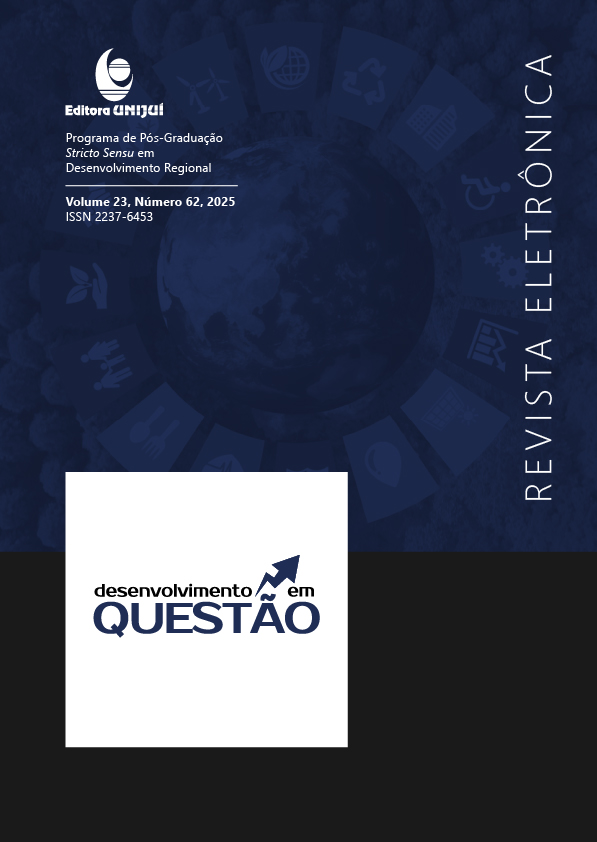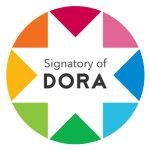Intangibilidade e desempenho econômico das empresas do agronegócio brasileiro listadas na B3
DOI:
https://doi.org/10.21527/2237-6453.2025.62.16485Palavras-chave:
Agronegócio, Intangibilidade, Rentabilidade, EconometriaResumo
Os ativos intangíveis têm se destacado na criação de valor na atual economia do conhecimento, propiciando maior eficiência econômica e financeira para as firmas. Os investimentos em ativos intangíveis tendem a se correlacionar positivamente com o desempenho econômico empresarial, reflexo da maior competitividade. Este artigo avalia a relação entre intangibilidade e performance financeira das empresas do agronegócio negociadas na B3. Foram estudadas 8 empresas/ano no período de 2012-2022, as maiores em termos de capital patrimonial. A avaliação econométrica evidenciou que o aumento dos intangíveis afeta positivamente o retorno sobre o patrimônio líquido das empresas, embora não explique o retorno sobre o ativo total. Este artigo oferece uma contribuição para a literatura empírica brasileira sobre a relação entre intangibilidade e rentabilidade, em especial ao agronegócio, ao revelar a importância dos recursos intangíveis como determinantes das vantagens competitivas de empresas. Dentre as ressalvas necessárias ao interpretar estimativas, ainda que o modelo esteja bem ajustado, estão especificidades do período analisado a amostras relativamente pequena.
Referências
AGUIAR, G. A.; TORTOLI, J. P.; FIGARI, A. K. P.; PIMENTA, T. Analysis of the influence of intangible assets on the performance of Brazilian companies. Revista de Administração (UFSM), v. 14, n. 4, p. 907-931, 2021.
AKINLO, O.; ASAOLU, T. Profitability and leverage: evidence from Nigerian firms. Global Journal of Business Research, v. 6, n. 1, p. 17-25, 2012.
ALNAA, S. E.; MATEY, J. Implications of financial leverage for bank profitability in Ghana. Journal of Accounting, Business and Finance Research, v. 17, n. 2, p. 55-63, 2023.
ANSOFF, H. I. Estratégia empresarial. São Paulo: McGraw Hill, 1977. 268 p.
ANTUNES, M. T. P.; MARTINS, E. Capital Intelectual: Verdades e Mitos. Revista Contabilidade & Finanças, v. 29, n. 1, p. 41-54, 2002.
ANTUNES, M. T. P. Capital intelectual. São Paulo: Atlas, 2000. 22 p.
BARROS, G. S. C. Agronegócio: conceito e evolução. São Paulo: Cepea-USP, 2022. 10 p.
BATABYAL, D. Measuring performance of hotels in Kolkata: an empirical study through VAICTM method. In: RAY, N.et al.. (org.) Strategic infrastructure development for economic growth and social change. Buthan (India): IGI Global. 2015.
BHARATHI, K. G. The intellectual capital performance of banking sector in Pakistan. Pakistan Journal of Commerce and Social Sciences, v. 4, n. 1, p. 84-99, 2010.
BILLETT, M. T.; MAUER, D. C. Cross-Subsidies, Corporate Financial Policy, and the Distribution of Value in Firm Restructurings. The Journal of Finance, v. 58, n. 3, p. 1247–1287, 2003.
BONTIS, N. Assessing knowledge assets: a review of the models used to measure intellectual capital. International Journal of Management Reviews, v. 3, n. 1, p. 41-60, 2001.
CHEN, M. C.; CHENG, S. J.; HWANG, Y. An empirical investigation of the relationship between intellectual capital and firms’ market value and financial performance. Journal of Intellectual Capital, v. 6, n. 2, p. 159-176, 2006.
COLAUTO, D. R.; NASCIMENTO, P. S.; AVELINO, B. C.; & BISPO, O. N. A. Evidenciação de ativos intangíveis não adquiridos nos relatórios da administração das companhias listadas nos níveis de governança corporativa da Bovespa. Revista Contabilidade Vista & Revista, v. 20, n. 1, p. 142-169, 2009.
CORRADO, C. A.; HULTEN, C. R. Intangible Capital and Economic Growth. The Role of Intangible Capital in the Knowledge Economy. Amsterdan: Elsevier, 2025. 52 p.
DAVIS, J. H.; GOLDBERG, R. A. A Concept of Agribusiness. Cambridge: Harvard University Press, 1957. 152 p.
DIERICKX, I.; COOL, K. Asset Stock Accumulation and Sustainability of Competitive Advantage. Management Science, v. 35, n. 12, p. 1504–1511, 1989.
DRUCKER, P. Technology, Management and Society. New York: HarperCollins, 1970. 184 p.
EDVINSSON, L.; MALONE, M. S. Capital intelectual: descobrindo o valor real de sua empresa pela identificação de seus valores internos. São Paulo: Makron Books, 1998. 214 p.
FARIA, G. G.; CARVALHO, L.; PEIXOTO, F. M.; BORSATTO, J. M. L. S. Governança corporativa e a intangibilidade: um estudo em empresas brasileiras não financeiras da B3. Iberoamerican Journal of Strategic Management, v. 19, n. 4, p. 58-75, 2020.
FERLA, R.; MULLER, S.; KLANN, R. Influência dos ativos intangíveis no desempenho econômico de empresas latino-americanas. Brazilian Review of Finance, v. 17, n. 1, p. 35-50, 2019.
FERREIRA, A. I.; MARTINEZ, L. F. Intellectual capital: perceptions of productivity and investment. Revista de Administração Contemporânea, v. 15, n. 2, p. 249-260, 2011.
GHEMAWAT, P. A estratégia e o cenário dos negócios. Porto Alegre: Bookman, 2008. 232 p.
GIL, A. C. Como elaborar projetos de pesquisa. São Paulo: Atlas, 2002. 208 p.
GREEN, J.; LOUIS, H.; SANI, J. Intangible Investments, Scaling, and the Trend in the Accrual–Cash Flow Association. Journal of Accounting Research, v. 60, n. 4, p. 1551-1582, 2022.
GRINBLATT, M.; TITMAN, S. Mercados financeiros & estratégias corporativas. Porto Alegre: Bookman, 2005. 724 p.
GUJARATI, D. Econometria básica. Rio de Janeiro: Campus, 2006. 845 p.
HENDRIKSEN, E. S.; BREDA, M. F. Teoria da contabilidade. São Paulo: Atlas, 1999.
ITAMI, H. Mobilizing Invisible Assets. Cambridge: Harvard University Press, 1987. 200 p.
JOHAN, S. Determinant efficiency of financial institutions in emerging market. Journal Manajemen dan Pemasaran Jasa, v. 12, n. 2, p. 165-176, 2019, 2019.
KAMASAK, R. The contribution of tangible and intangible resources, and capabilities to a firm’s profitability and market performance. European Journal of Management and Business Economic, v. 26, n. 2, p.252-275, 2016.
KAYO, E. K; KIMURA, H.; BASSO, L. F. C.; KRAUTER, E. Os fatores determinantes da intangibilidade. Revista de Administração Mackenzie, v. 7, n. 3, p. 112-130,2006.
KAYO, E. K.; FAMÁ, R. A estrutura de capital e o risco das empresas tangível-intensivas e intangível-intensivas. Revista de Administração da Universidade de São Paulo, v. 39, n. 2, p. 164-176, 2004.
LEV, B. Intangibles: Management, measurement, and reporting. Brookings Institution Press, 2001. 231 p.
LEV, B.; GU, F. The End of Accounting and the Path Forward for Investors and Managers. Conflict Between Intangible Assets and Economic Returns, Wiley, 2024.
LIM, J. Services 4.0: a new wave of innovation and partnerships. Ethos, v. 21, July 2019, p. 1 – 5, 2019.
LIMA, A.; TELES, J.; BORNIA, A. C.; FRAZZON, L. S. Relação entre a intangibilidade e o desempenho econômico em empresas brasileiras de capital aberto. In: CONGRESSO BRASILEIRO DE CUSTOS, 21., Natal. Anais [...]. São Leopoldo/RS: Associação Brasileira de Custos, 2014.
LOPES, F. C.; CARVALHO, L. Intangible assets and business performance in Latin America RAUSP Management Journal, v. 56, n. 4, p. 408-424, 2021.
MACHADO, G. A.; CARVALHO, L.; PEIXOTO, F. M. A relação entre intensidade tecnológica e grau de intangibilidade no desempenho econômico-financeiro da indústria brasileira. Gestão & Regionalidade, v. 33, n. 99, p. 1-18, 2017.
MANTOVANI, E.; SANTOS, F. A. A contabilização do ativo intangível nas 522 empresas listadas na BM&FBOVESPA. Review of Administration and Innovation, v. 11, n. 4, p. 310-328, 2014.
MARTINS, G, A.; THEÓPHILO, C. R. Metodologia da investigação científica para ciências sociais aplicadas. São Paulo: Atlas, 2007. 264 p.
MAZZIONI, S.; RIGO, V. P.; KLANN, R. C.; DA SILVA JUNIOR, J. C. A. A relação entre a intangibilidade e o desempenho econômico: Estudo com empresas de capital aberto do Brasil, Rússia, Índia, China e África do Sul (BRICS). Advances in Scientific and Applied Accounting, v. 7, n. 1, p. 122-148, 2014.
MEDRADO, F.; CELLA, G.; PEREIRA, J. V.; DANTAS, J. A. Relação entre o nível de intangibilidade dos ativos e o valor de mercado das empresas. Revista de Contabilidade e Organizações, v. 10, n. 28, p. 32-44, 2016.
MENDES, J. T. G.; PADILHA, J. B. Agronegócio: uma abordagem econômica. São Paulo: Pearson, 2007. 384 p.
PORTER. M. Vantagem competitiva: criando e sustendo um desempenho superior. Rio de Janeiro: Campus, 1980. 932 p.
PUCCI, T.; SIMONI, C.; ZANNI, L. Measuring the relationship between marketing assets, intellectual capital, and firm performance. Journal of Management and Governance, v. 19, p. 1–28, 2015.
PULIĆ, A. VAICTM – an accounting tool for IC management. International Journal of Technology Management, v. 20, n. 5, p. 702-714, 2000.
RITTA, C. D. O.; ENSSLIN, S. R. Investigação sobre a relação entre ativos intangíveis e variáveis financeiras: um estudo nas empresas brasileiras pertencentes ao índice IBovespa nos anos de 2007 e 2008. In: CONGRESSO USP DE CONTROLADORIA E CONTABILIDADE, 10., São Paulo. Anais [...], São Paulo: Universidade de São Paulo, 2010.
SCHMIDT, P.; SANTOS, J. L. Avaliação dos ativos intangíveis. São Paulo: Atlas, 2002. 191 p.
SQUENA, R.; PASUCH, D. F. Goodwill: sua definição e relevância para a área contábil. Revista Gestão Organizacional, v. 3, n. 1, p. 44-57, 2010.
TUDOR, A., T.; DIMA., S.; DIMA, B.; RAŢIU, R. V. The linkage between intangibles and profitability. Annales Universitatis Apulensis Series Oeconomica, v. 16, n. 1, p. 283-293, 2014.
VILLALONGA, B. Intangible resources, Tobin’s q, and sustainability of performance differences. Journal of Economic Behavior & Organization, v. 54, n. 2, p. 205-230, 2004.
WOOLDRIDGE, J. M. Introdução à econometria: uma abordagem moderna. São Paulo: Cengage, 2010. 878 p.
Downloads
Publicado
Como Citar
Edição
Seção
Licença
Copyright (c) 2025 Carlos Henrique Rocha (in memoriam), Paulo Augusto Pettenuzzo de Britto, Gladston Luiz Silva, Filipe Lopes Meireles

Este trabalho está licenciado sob uma licença Creative Commons Attribution 4.0 International License.
Ao publicar na Revista Desenvolvimento em Questão, os autores concordam com os seguintes termos:
Os trabalhos seguem a licença Creative Commons Atribuição 4.0 Internacional (CC BY 4.0), que permite:
Compartilhar — copiar e redistribuir o material em qualquer meio ou formato;
Adaptar — remixar, transformar e criar a partir do material para qualquer fim, inclusive comercial.
Essas permissões são irrevogáveis, desde que respeitados os seguintes termos:
Atribuição — Atribuição — os autores devem ser devidamente creditados, com link para a licença e indicação de eventuais alterações realizadas.
Sem restrições adicionais — não podem ser aplicadas condições legais ou tecnológicas que restrinjam o uso permitido pela licença.
Avisos:
A licença não se aplica a elementos em domínio público ou cobertos por exceções legais.
A licença não garante todos os direitos necessários para usos específicos (ex.: direitos de imagem, privacidade ou morais).
A revista não se responsabiliza pelas opiniões expressas nos artigos, que são de exclusiva responsabilidade dos autores. O Editor, com o apoio do Comitê Editorial, reserva-se o direito de sugerir ou solicitar modificações quando necessário.
Somente serão aceitos artigos científicos originais, com resultados de pesquisas de interesse que não tenham sido publicados nem submetidos simultaneamente a outro periódico com o mesmo objetivo.
A menção a marcas comerciais ou produtos específicos destina-se apenas à identificação, sem qualquer vínculo promocional por parte dos autores ou da revista.
Contrato de Licença (para artigos publicados a partir de 2025): Os autores mantêm os direitos autorais sobre seu artigo, e concedem a Revista Desenvolvimento em Questão o direito de primeira publicação.











